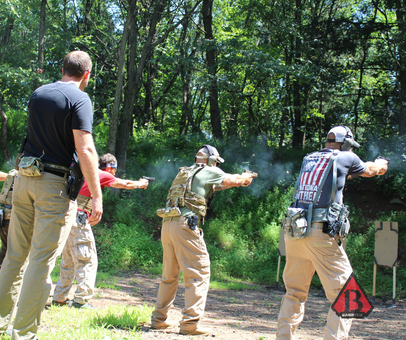|
What would happen if you could get accurate hits on target in less than 2 seconds? What about 1 second? It could help you… Better prepare yourself to survive a life or death situation. Become a better protector. Develop more confidence. And that’s just what it did for Adam. When Adam came to us, he was a decent shooter with his handgun, but had never practiced much working from the holster. When presenting from the high ready, he could drill a nice shot group in the paper, but when we had him shoot from the draw, his speed and accuracy suffered. I ran Adam through some reps and began observing him. It wasn’t long before I had him down to almost a 1.5 second draw. Not bad! Adam didn’t need to burn through thousands of rounds to improve and neither do you. I'm going to share the same program with used with him and countless others. Are you ready to level up? To run this program, you’re going to need a shot timer and some other things, but don’t worry. You don't have to buy anything to get started. In fact, I put together this handy field guide with links to the things you need all in one place.
Just click here to get free access. Before you begin this training protocol, you have to have the necessary background and experience in the safe use and handling of firearms and adhere to the fundamental rules of firearms safety listed below. If you lack the background and experience in this matter, please seek out training from a professional firearms instructor in your area before attempting this protocol. Always observe the 4 Rules of Firearm Safety: 1. Treat every weapon as if it is loaded. 2. Never point the gun at anything you're not willing to destroy. 3. Keep your finger off the trigger until ready to fire. 4. Be sure of your target and what is behind it. HOW IT WORKS Step 1: DRY FIRE SESSION Each day you will conduct a 15-20 minute dry-fire session for five days in a row. What is dry-fire? Dry-fire training is simply the act of simulating the firing of your weapon without live ammunition. To guide your dry-fire practice, we will be using the Deliberate Practice drill as by Travis Haley. The video is free and on youtube. I've included the link in your the free training guide here. As a caveat, Haley uses Deliberate Practice as a live-fire drill. It’s absolutely perfect for that, but we also be using it as part of our dry-fire practice. When running this drill, make sure you check and recheck to ensure there's no live ammunition in the weapon or your magazines. Before you begin, choose a small focal point to present to, say, a 3x5 index card. This will force you to intentionally slow down, focus on your front sight, and acquire a proper sight picture. Stand off approximately 5 yards away from the target, and begin your session. Do this for 5-days straight. Step 2: LIGHTS, CAMERA, ACTION! Once you've finished your Deliberate Practice dry-fire session, conclude your training by by filming yourself performing six to eight draw strokes and about 80-percent of your full speed. The reason I want you to go less than your full speed is because our objective is to build proper mechanics. It's early in the process and we don't want to run the risk of inserting jerky or twitchy muscular movements into the process and undoing all of our work. Remember, we're tying to eliminate unnecessary movement, not add additional ones. The time for full speed will come. Let's make sure we get the mechanics right first. Step 3: CUT THE FAT Watch the video you recorded of your session and analyze your results. The reason why we film is because it's very hard to diagnose yourself while you're going through the actions. Filming allows you to be your own coach. You can observe yourself and make corrections as needed. The main thing we are looking for is to cut out any unnecessary movement. Look for bowling, fishing, or jackhammer motions as you present to the target. If you see any of that in the video, make a note of it and correct it in the next day's practice sessions. If you want to do a little extra work on your downtime, visualize yourself conducting a perfect draw at speed, hitting the target successfully. Step 4: RANGE DAY! It’s range day! Take a box of rounds and head to the range. Stand about 5 yards away from the target. Select a standard paper plate sized point to aim your shots. Use any target you like, but I literally staple a white paper plate to my cardboard IDPA targets. They're cheap and easy to replace. Warm up with a few dry-fire draw strokes. When you’re ready, safely load and conduct your training session utilizing the Deliberate Practice video - this time as a live fire drill. Make sure you save some ammo so you can film yourself doing some reps. This is now your new baseline when it comes to your draw. Step 5: ASSESS AND ADJUST So how did you do? Did you improve over the course of the week? What happened when you went to range? Record your results and assess where you are? Decide if you want to work on other aspects of your shooting or if you want to continue on with the program. If you want to continue working on your draw, just repeat the program and reassess at the end of the week. It’s simple, easy to execute, and it works. So, be safe and have fun with it. And let me know your results! If you get stuck or have any questions, just give me a shout and I’ll help you anyway I can.
5 Comments
8/24/2022 02:49:48 pm
I'm glad you described firearm safety rules and how they're a must for any practitioner. I heard that my cousin wants to learn how to use a firearm this year, so before he gets started, I'll share your safety tips with him. Thank you for the advice on learning the basics before improving your shooting speed.
Reply
Barritus Defense
1/12/2023 01:42:19 pm
Hey Eli,
Reply
I like that you pointed out that it is best to have the experience of handling a firearm safely and learning its fundamentals before you learn how to draw faster. In that case, I should probably attend firearms safety classes before I even get my own handgun this year for my own peace of mind regarding being cautious in handling it. I just really want to have something I can use to defend myself, especially when I live on my own here in Montgomery County, Texas.
Reply
Barritus Defense
1/12/2023 01:46:59 pm
Hey Mia,
Reply
2/10/2023 08:45:46 pm
I find it interesting when you said that we should record our progress and assess our improvements to help us get better. I will keep that in mind now that I plan to go to a used gun trading shop to buy myself a firearm. My purpose is to use it as a self-defense tool now that I live on my own and away from relatives and friends to start anew.
Reply
Leave a Reply. |
Archives
November 2023
Categories |



 RSS Feed
RSS Feed